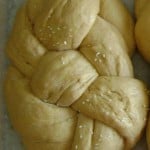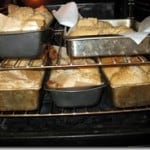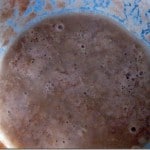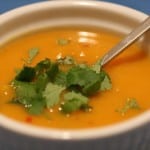In this short video, I share how to braid a challah using two strands. I got the idea from Ted at “There’s a Fire in My Kitchen,” a blog that is now inactive. Unfortunately he didn’t show exactly how to do the braiding, so I improvised a little. You can find the recipe for the […]
How I Cut My Baking Time in Half
There’s a reason bread is traditionally made in loaves. Loaf pans keep the bread from spreading, and slices are even and easy to use in sandwiches. They also save baking time.
Making a Traditional Food Healthier: Blintzes (Cheese-Filled Crepes)
We all remember traditional holiday foods from our childhood. But as adults, do we make adjustments in the recipe to make it healthier? I use blintzes, the fried, cheese-filled crepes served on the Jewish holiday of Shavuot (Pentecost) as an example.
Ripening Sourdough: Images at Various Stages
To make sourdough starter, all you need is equal measures of flour and water. Stir it every day for a few days. At some point, usually after two to four days, the starter will be ready for feeding.
For more detailed instructions, see Make Your Own Sourdough Starter at Home.
When Do I Start “Feeding” My Starter?
- When you see tiny bubbles throughout the batter, it’s time to start feeding. You may have to enlarge this picture to see the bubbles. When you see plenty of bubbles throughout the batter, even after you stir it, discard about half of your starter. Add a cup each of flour and water. Do this every day until the starter is ripe.
The Best Techniques for Knowing When Food is Cooked
In my post, The Secret to Great Home Cooking, I explained that the key to good food is to cook it until it’s done, and no longer. But this isn’t always easy. Cooking times in recipes are only a guide. For instance, older beans and vegetables take longer to cook than fresher ones. Cuts of meat are different sizes, and our cooking equipment and even the weather affect a recipe. But once you can accurately tell when food is done without consulting a cookbook, your cooking skill has reached a new level.
So how do you know when food is ready to serve?
Twenty Tips to Avoid Soup Powder or Canned Broth
It’s funny to be writing a post about substitutes for soup powder or canned broth. Soup powder was invented as a shortcut to making soup the good old-fashioned way. With apologies to my vegetarian readers, the best soup is made by simmering bones or meat in water for a good long time.
Why not use powder or cans? Processed soup may contain monosodium glutumate, starches, artificial flavors and preservatives and excessive amounts of salt. Monosodium glutumate adds flavor but gives some people stomach problems. And while we do need starch and sodium in our diet, it’s better to have control over how much and in what form.
Soup powder is meant to add flavor and texture. But we can do that with simple foods that we have at home. Try one of two of these techniques the next time you make soup. Adjust flavors along the way, write down your successes, and soon you will find yourself making great soup from scratch.
Converting Commercial Yeast Recipes to Sourdough
Laurie Ashton is a Twitter friend who caught my attention with her recipe for sourdough challah. When Aleeza asked how to convert regular yeast recipes to sourdough I thought of Laurie, and sure enough, she came through with a clear and thorough explanation. Her guest post is below.
Convert Standard Yeast Recipes to Sourdough
Guest post by Laurie Ashton
I’m not a long-time sourdough baker – I’ve only been baking sourdough (wild yeast) bread for the last couple of years. Since I don’t digest commercial-yeasted bread well, I use sourdough exclusively, which also means trial and error in converting recipes to sourdough.
Learning to Cook, Step by Step
When I wrote Make Your Own Sourdough Starter at Home, I also started a discussion on the Facebook fan page to walk readers through it.
Here’s what Aleeza had to say:
Guess what I don’t get is why recipes can’t be simple. I need directions with numbers like step 1, 2, 3, 4.
The Secret to Great Home Cooking
My friend, whose recipes have won prizes, once said to me, “You’re a great cook.” I was surprised at the compliment. “My mother was a great cook,’ I replied. “I just cook basic recipes.” It’s true. I don’t pore through cookbooks or seek out special ingredients like my friend does. I enjoy cooking, but I don’t want to spend all my time in the kitchen. “Yeah,” she replied. “But when you serve chicken, it’s moist and flavorful. Do you know how many people serve dry chicken?”
I’ve often thought about my friend’s comment.Tens of thousands of cookbooks, websites and courses teach people how to cook. Collecting recipes, experimenting with spices, techniques and food combinations are important. But if you, as a home cook, master only one thing, you will be ahead of the pack:







